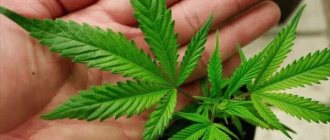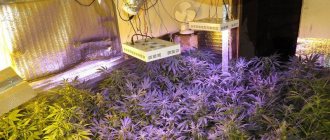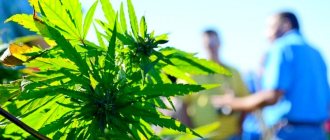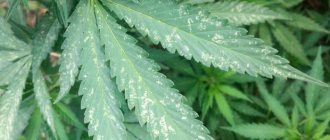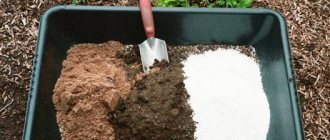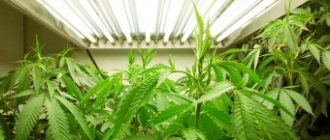The question: “how can you grow hemp at home” is extremely relevant for almost all novice growers. Following the trends of Western countries, where cannabis is no longer taboo, the topic of progressive plant growing is becoming increasingly popular. Growing marijuana is turning into a hobby for many people, placing their favorite plant in their closet, windowsill or pantry. This way they manage to satisfy their needs in a finished product whose quality they can vouch for.
In this article, we will not go into details of the cultivation process itself, but in general terms we will talk about 3 possible ways to grow hemp at home. We will also tell you what conditions will contribute to this, and estimate the approximate cost of the project, so that every new grower knows what is required of him to grow cannabis at home.
Where to begin
First, let's eliminate any fear that this will be difficult. Will not be. An important aspect of home growing that everyone should understand is that hemp is a flowering plant, which means that in nature it bears fruit only once a year in the fall, when there is less daylight. This is important for home indoor plant growing because the light regime (photoperiod) of the plant must be controlled. To put it simply, this means that the plant in the pot must receive more than 12 hours of light every day in order not to bloom. You may ask, “Why not just let the plant flower immediately, collect the beautiful buds, and start smoking?” Truth be told, you could do it. But if an unripe bush blooms too early, there will be little harvest. To achieve a healthy, well-developed crop, young seedlings should be grown for 4-6 weeks before inducing flowering. During this time, the bush should receive at least 16 hours of light, 18-20 hours is also quite good. To do this indoors, even near a window with good sunlight, you will need a lamp to ensure the proper photoperiod length.
Where to grow cannabis at home?
The second thing you need to do is decide on the growing location, for example, place the pots on the windowsill, in the room, on the loggia or even in the basement. To maintain the best growing conditions for cannabis, you can use special containers - grow boxes, which do not take up much space and can be placed in any room. A more economical option for a grower is to purchase a grow tent. This is a kind of tent for plants, made of reflective material. It can be stored and used as needed.
Like the grow box, the grow tent has special mounts for climate control and lighting devices. It is still advisable to give preference to cultivation inside the apartment, because this will make it easier for you to maintain the required temperature and humidity. At the vegetative stage, the air temperature should be within 25-26°C, with a humidity of 65-75%. When cannabis begins to bloom, the optimal values are 23-24°C, 42-50%, respectively. If you decide to start cultivating on the balcony, then pay great attention to camouflage: the bush should not be noticed by others.
Lighting
One of the main tasks of a grower is to provide light to the plants. Autoflowering cannabis varieties are more stable and less whimsical, but they will not have enough light even on the windowsill, so you should carefully take care of this and, if necessary, purchase special lamps. This will not be necessary when using a fully equipped grow box, because, as a rule, this device is already equipped with lamps. For the cultivation of cannabis, lighting devices from the following models are used:
- DNAT;
- LED;
- DID;
- DNaZ.
The most popular from the list are HPS lamps. They are the most powerful, illuminate the space well, and are suitable for use at all stages of cannabis development. The only point that a novice grower should pay attention to is the distance of the lighting devices from the top of the plant. The optimal distance is 30-60 cm.
Lighting
Your lamp will be the most expensive part of the process, but there are relatively inexpensive lamps available for this purpose. Serious growers use more specialized and expensive lamps. But for growing just one plant at home, there are many easy options. You can find a 250-watt HID or HPS bulb in hardware stores. These lamps require special mounting or ballast as they do not securely screw into any standard household socket. If your windowsill has a lot of light and sun, you can alternatively use fluorescent lights to supplement the sunlight after sunset. Fluorescent lamps such as T5, T8 or even CFL can provide enough light to support your plant through the growing season. However, remember, the less intense the light, the slower the plant will develop. For plants that receive strong sunlight during the day, fluorescent bulbs should only be used as a supplemental light source. If the light provided during the day is too low, the plant will be thin and weak and not develop enough to harvest. If so, consider using a 250-watt HID option for a full 12-hour photoperiod during flowering, away from a window, in a separate, enclosed area.
Blowing marijuana bushes
Don’t be surprised, but at home you can get high-quality hemp, as evidenced by the quality and quantity of the harvest. In this matter, air circulation plays an important role. Is it worth spending money on fans? Absolutely, and here's why:
- By adjusting the airflow intensity you can control humidity and temperature;
- mold and mildew will not grow in cannabis inflorescences;
- metabolism in the plant is accelerated, which allows you to grow buds with a high content of THC and other cannabinoids;
- The root system of the crop develops correctly.
The blowing system must be installed at the bottom of the grow tent, and also at the top or side. Please note that fans should not direct the air flow directly to the bushes, but blow upwards or onto one of the walls.
We provoke flowering
Once your plant has developed enough and can produce enough flowers for a decent harvest, it is time to work up the light cycle to 12 hours of light and 12 hours of darkness each day. This doesn't mean you won't need your lamp anymore. During the 12-hour flowering photoperiod, cannabis needs strong light, which can help it produce energy for its buds. If your plant can be exposed to direct sunlight during those 12 hours, you won't need much supplemental lighting. However, even outdoors this is usually not possible. Your best option for flowering is to move the pot to an enclosed area, such as a closet or pantry, where you can hang a lamp overhead and precisely control the light cycle as needed. To do this, use a standard output timer and set it to a 12-hour cycle. During the dark cycle, it is extremely important to keep light out of the plant's space. Any slight leaks can disrupt the plant's flowering, stress or confuse the plant, causing it to become hermaphrodite (self-pollinate and produce buds with seeds) or severely reduce yield and quality.
Choose the right strain
It is logical to assume that in order to grow, you must first order cannabis seeds. Autoflowering varieties are more suitable for growing cannabis indoors, namely: Auto Lowryder, Auto Skunk, Auto AK - 47 and others. What do all these cannabis strains have in common? The above strains are low-growing, unpretentious, and productive. And most importantly, they begin to bloom on their own, without waiting for action from the grower. You won't have to change your lighting schedule, and if you set your marijuana bush to an 18/6 schedule while still in the vegetative stage, you can stick to it right up until harvest.
Flowering will begin the moment the plant reaches a certain maturity. And no dancing with a tambourine - the culture will develop as expected, with minimal deviation from the deadlines, and practically without the participation of the cannabis grower. If you want to make your life even easier, then order varieties from the “feminized” category. This means that only female bushes will grow from the seeds, and at the end of the cultivation you will get a huge harvest of sinsimilla.
Other tips and tricks
Besides lighting and the possible need for a confined space, you may also be concerned about potting options, the best type of soil, and nutrients for your plant. Since we are talking about only one plant, there are many suitable options for these aspects. The best options for containers are those that are breathable, such as fabric pots. Other potting ideas include drainage holes and saucers for drainage. Remember that your plant should not sit in standing water for long as the pH will change and eventually change the soil and the plant. Stagnant water also attracts bedbugs and mold. In terms of substrate, a small bag of organic potting soil usually works great for houseplants. Peat, coconut or sphagnum substrates are also excellent choices. Be sure to choose a breathable substrate that will allow air to penetrate into the roots. They breathe oxygen, and the plant above ground breathes CO2. Some substrates, especially organic ones, may contain soft, already mixed nutrients such as guano or seaweed. This will reduce the amount of nutrients you will need so that your plant may not require any feeding at all until it begins to flower. When it comes to nutrient recommendations, stick to organic. Stay away from salty synthetic and artificial nutrients - they will cause more problems than they are worth. Beyond these points, remember that growing cannabis, or any houseplant, is what connects you to nature. The goal is to enjoy the process, learn and have fun
Let's sum it up
Of course, a comfortable home environment is radically different from “wild” growing conditions, when cannabis grows under the rays of the sun and sways under a powerful flow of wind. However, an impressive harvest of hemp buds indoors can become a reality. This can be achieved if you buy marijuana seeds of decent quality and follow the optimal conditions and necessary recommendations for growing cannabis. If you are ready to spend, you can completely automate the growing process. Specialized stores offer a huge assortment of various sensors, devices for climate control, irrigation, etc., which greatly saves the time and effort of the hemp grower. It is not necessary to purchase everything at once - for the first cultivation experience, a substrate, 10-15 liter pots, lamps and seeds are enough. Good luck!
More fertilizer does not mean more flowers
You want to highlight as much “useful” as possible in your planting, because you are trying for yourself. At the beginning of his passion for gardening, the author feverishly sorted through all the suitable fertilizers offered by the Internet, while the eternal questions “Which fertilizer to choose?” were shining in his boiling head. What other additives should I take to achieve active growth and a large flower mass?” In fact, additional additives turned out to be a phenomenon similar to the technical bells and whistles used by advanced growers: if you do not understand what exactly a mineral additive is for, it is better not to pollute the soil with excess mineral salts. It is recommended for a novice cannabis grower to use basic fertilizers suitable for cannabis (tomatoes are a guideline; if the fertilizer is suitable for tomatoes, then it is also suitable for cannabis) and monitor the comfort of the plants - temperature 23-26°C, vigorous (but not aggressive) air circulation and ventilation, adequate watering (don't overdo it either). Under ideal conditions, hemp with the most basic fertilizers will produce a powerful harvest. If you overdo it with additives, you risk poisoning the plants.
Growing hemp is easy!
Reading the reports of experienced growers, especially professionals, a beginner can become desperate - such difficulties sometimes seem unthinkable to be repeated. The truth is that professional growers figure out all the subtleties and technical bells and whistles as they cultivate. In other words, if some subtlety in their performance is not clear to you, you don’t have to rack your brains trying to repeat it. If you're just starting out, you'll need a couple of days of preparation, then 10-15 minutes of inspection and care every day, plus a few days after harvest (on time, not earlier or later) for drying and curing. The most difficult thing in growing is to protect your planting from prying eyes (if outdoors) and maintain a cool temperature and active air circulation with powerful lighting (in a growbox), nature will do the rest for you.
Advice from experienced people is great, but not always useful
If you communicate with experienced growers, learning from them is undoubtedly very useful. BUT: when you intuitively don’t want to apply some advice from an older comrade, don’t apply it. Your own opinion is paramount because no one knows your plants better than you. Even an experienced cannabis grower is sometimes able to give another advice that is adequate only in the context of specific genetics or specific growing conditions. In other words, not everything will suit your case, so your attitude to recommendations should be attentive, but also critical. The plants in the photo below were raised in the same conditions, but due to different genetics, one produced one and a half times more yield than the other. Each bush is individual.
Continuing the topic of sharing experiences: it is undoubtedly useful for a novice grower to read the forums of grower communities, even if you do not put absolutely all the information into practice.
We wish you good luck in your endeavors! If you liked the article, be sure to rate it!
Proper ventilation prevents illness
Sufficient air circulation prevents a whole bunch of problems:
- plants develop more actively;
- the stem strengthens and transports nutrients faster;
- less likelihood of fungal diseases and stake rotting;
- it is difficult for fungus gnats and spider mites to cause an epidemic;
And it is important not to overdo it - the bushes should rustle a little, and not tremble in horror from being blown away. One of the most common diseases indoors is white powdery mildew. Most often, growers encounter this problem when they place a pot with a plant and a lamp in a closed cabinet without an exhaust hood. Stagnant, overheated air is an invitation for powdery mildew. Symptoms are white mounds on the foliage that look like flour. Smoking/eating leaves or inflorescences affected by powdery mildew is unsafe for health. At an early stage, it is easy to eliminate the disease with a remedy like SM-90; a progressive disease can destroy the entire planting. Keep in mind that after eliminating powdery mildew, you must also correct the conditions that led to its appearance! Perhaps the air humidity in the grow box is too high, which is especially dangerous for plants in the middle of the flowering phase, when the colas are already thick and dense.
Have you decided to grow cannabis at home? Light is most important!
Your task is to choose the most powerful lighting device that will not burn the plants, and also to illuminate the bushes as evenly as possible - which is achieved with a variety of garters, the SCRoG method and other methods of correcting the shape and direction of marijuana growth. Keep in mind that too much light can burn plants even at normal temperatures - if the most illuminated areas show signs of light, you need to either move the plant further away or use a less powerful lamp.
Genetics is the basis of the result
Be sure to choose a strain based on your growing conditions. Of course, if you really want to, you can always wriggle out and bend an overgrown growbox plant so that the lamp does not burn it. You can even build a greenhouse around a ripening bush in the fall, and spend the night in it with a small fire so that the first cold does not destroy your planting. However, it is much more practical to choose a strain that is suitable in size and ripening time, so that your attention and efforts are spent on improving the living conditions of cannabis, and not on desperate attempts to save it. For this reason, it is advisable to plant seeds of unknown cannabis (which are obtained from purchased buds or from familiar growers) only if you have space to spare and you are sure that you want to experiment.
In this photo we see a plant that has matured in 60 days (from the beginning of flowering). Only 2 months, and the flower mass is impressive - all thanks to the selected Auto Big Bang genetics from Divine Seeds.
